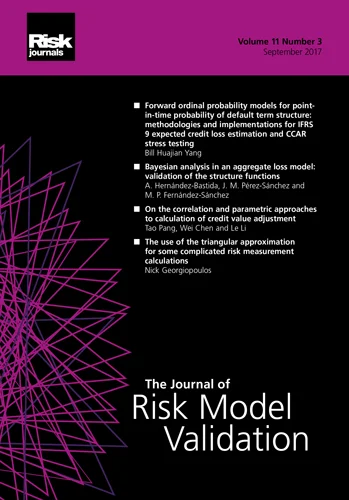Journal of Risk
ISSN:
1465-1211 (print)
1755-2842 (online)
Editor-in-chief: Farid AitSahlia
Volume 27, Number 1 (October 2024)
Editor's Letter
Farid AitSahlia
Warrington College of Business, University of Florida
This issue of The Journal of Risk covers expectile quadrangles, asymptotic singlerisk factor (ASRF) models, coherent stress testing and the potential impact of bonus caps on bankers’ risk-taking.
In the issue’s first paper, “Expectile risk quadrangles and applications”, Anton Malandii, Viktor Kuzmenko and Stan Uryasev use the fundamental risk quadrangle (FRQ) framework to determine a number of results regarding the expectile risk measure. In particular, with an emphasis on a new quadrangle where the expectile is both a statistic and a risk measure, they show the equivalence between expectile and conditional value-at-risk optimization as well as between expectile and quantile regressions. The authors validate their theoretical results numerically via case studies.
In our second paper, “Relaxing the assumption of conditional independence in an asymptotic single risk factor model”, Frederic Menninger extends the standard ASRF model, within the framework of dynamic credit provisioning and stress testing, by decomposing the systematic risk factor into the sum of an “observable” component (imputed from default data) that is potentially correlated with observable macroeconomic covariates and an “unobservable” component that is uncorrelated with observable macroeconomic variables. As a result, conditioning on the observable component does not induce dependence between default events: a model feature that is consistent with a large body of empirical evidence but is missing from the standard version of the ASRF model. In addition, Menninger shows that disregarding conditional correlation leads to inappropriately strict bounds for model performance monitoring, while, in conservative applications, ignoring conditional correlation leads to an underestimation of portfolio loss quantiles.
“We will shock you: a coherent Bayesian approach for stress testing”, the third paper in this issue, is by João Vinícius França Carvalho and Filipi Sanguino, who illustrate the application of dynamic Bayesian networks in unpredictable and unstable environments, specifically emerging markets. In the particular case of Brazil, they find that the country’s stock market is more sensitive to developments in advanced economies than to domestic factors. In particular their findings suggest that a declining Standard & Poor’s 500 rate, a positive exchange rate and a neutral Índice Nacional de Preços ao Consumidor Amplo (IPCA) inflation rate is a consistently aggressive combination that could lead to heightened economic volatility or uncertainty, with a significative probability mass function.
The issue’s fourth and final paper, “Bonus caps and bankers’ risk-taking”, is by Esa Jokivuolle, Jussi Keppo and Xuchuan Yuan, who use a principal–agent model to evaluate whether imposing a cap on bonuses reduces a banker’s propensity to take risks. Based on data from large US banks, the authors show that a bonus cap may have a sizable risk-reduction impact on only a small set of bankers: namely, those with extremely high bonus-to-salary ratios. Their results shed further light on why a more careful design of bonus cap regulation may be needed to improve its general effectiveness.
Papers in this issue
Expectile risk quadrangles and applications
The authors study the expectile risk measure within the fundamental risk quadrangle framework, constructing a new quadrangle where the expectile is both a statistic and a risk measure.
Relaxing the assumption of conditional independence in an asymptotic single risk factor model
Within the framework of dynamic credit provisioning and stress testing, this paper shows how conditional correlation impacts an asymptotic single risk factor model.
We will shock you: a coherent Bayesian approach for stress testing
The authors propose a novel coherent Bayesian stress test method which preserves the mathematical properties of the risk measures.
Bonus caps and bankers’ risk-taking
The authors investigate the relationship between bankers' risk-taking and bonus caps, finding negligible evidence that bonus caps reduce risk taking at the median bank.








